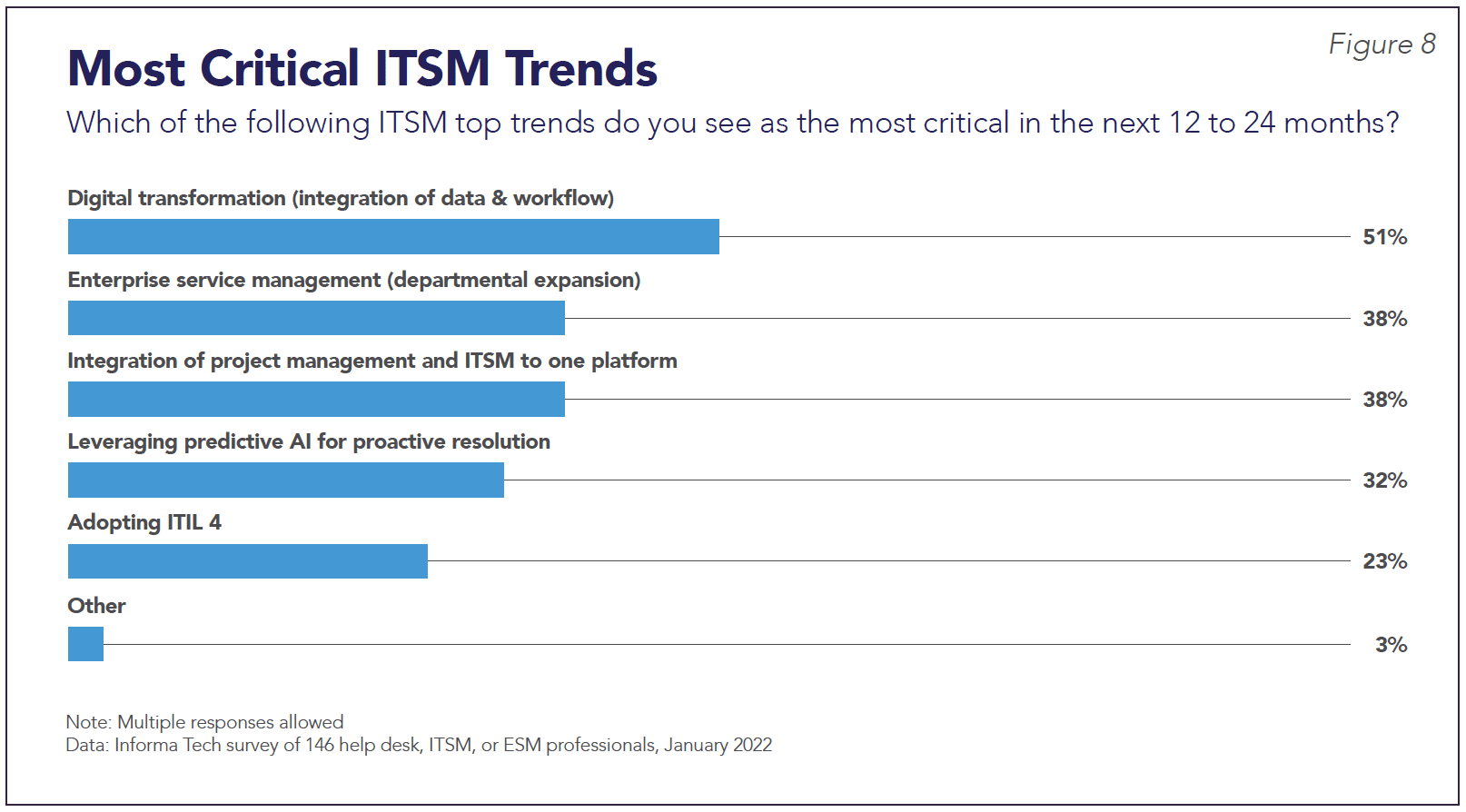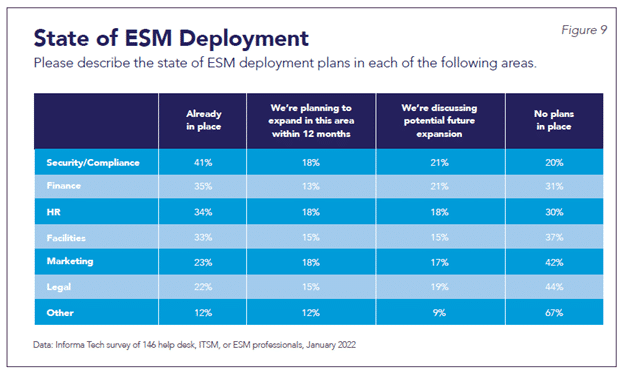Understanding Maturity Levels
As we assess the current state of IT Service Management (ITSM), one of the most obvious places to start is by asking those involved in the discipline how mature their practices and technologies truly are. ITSM is hardly a new niche in the world of IT, but it is one that has tended to evolve very organically in most organizations. So, mileage can vary, even at very large organizations, as to how far along they are in formalizing processes, standardizing technology and keeping that technology stack updated.
Nearly half of the organizations recently surveyed state they are on the low end of the maturity scale, and only about 8% believe that they operate with a very high level of maturity where their ITSM technology is fully optimized. Their IT group offers best-in-class service delivery through a formal program. At the same time, looking at the glass half full, the good news is that the majority-by-a-hair at 51% report a decent level of maturity with automation and at least some best practices in place.
Nevertheless, the results point to the fact that opportunities to improve performance and contain costs in many areas exist in most organizations.
Do Not Wait Until IT Has Everything ‘Perfect.’
Once organizations reach mid-to-high levels of maturity in IT Service Management, they are more likely to feel comfortable branching out into other departments. However, beware – often this becomes an obstacle to true Enterprise Service Management (ESM), as many IT organizations will stall the momentum because they are waiting until they are perfect.
The irony in this approach is that the other groups typically do not need as much functionality – for instance, change management and asset management are not used… why wait? *figure 2
Many organizations wait because the IT team is terrified of supporting all these different departments. Therefore, it is essential that you roll out a no-code solution. This will allow departments to easily add new forms, add fields, move fields and create workflows – without any coding, scripting or support from IT.

ESM and the Future of ITSM
As IT organizations plan for the future of service management, the overwhelming trend they’re preparing for is digital transformation. Approximately 51% of survey respondents report this as the most critical trend barreling for them in the next couple of years (Figure 8). This indicates that ITSM leadership will need to be cognizant of how their service platforms and workflows integrate with user technologies and, more appropriately, tie data and services together on the back end. This will be crucial in creating seamless digital experiences that drive transformation investments.

This push for end-to-end service is echoed by the next two critical trends, each named by 38% of respondents. Those are integrating ITSM and project management on a single platform and extending ITSM to other departments through broader ESM initiatives. Like the digital transformation trend, these two trends are also driven by the more tightly coupled and complex technology platform relationships needed to build digital ecosystems that enable critical business functions. ITSM groups must ensure that disparate platforms like Salesforce and DocuSign are well integrated to provide valuable functionality across numerous groups like business development, HR and legal.
Currently, only about 3 in 10 organizations have a formal ESM program to leverage ITSM principles outside of IT. However, work on this front is clearly underway. Even though many of them may not have an ESM program on the books, half the organizations have extended their ITSM or ticketing platform for use in managing work in other departments. Approximately a quarter of organizations say they’ve deployed ESM in more than two departments outside of IT.
Enterprise Self-Service Struggles with Usable Portals and Knowledge Bases
- Most organizations at least acknowledge the importance of self-service, with 81% reporting they have a knowledge base and 56% stating they run a self-service portal.
- However, only 5% of those with a knowledge base say that it is fully maximized with updated, crowdsourced relevant information.
- Only 25% of organizations with a self-service portal say it is highly adopted and effective in administering self-service support.
The good news is that a majority of organizations have, at the very least, started their self-service journey by developing a user knowledge base and by putting an end-user portal in place. Approximately 81% of organizations have a knowledge base of some sort and 56% of respondents run an end-user portal for self-service.
Beyond checking the box for these basics, however, organizations are still struggling to make the most of these processes. Among those with a knowledge base, approximately 47% of them admit that their knowledge base is very rudimentary with only basic information. Another 47% say that while they do have a large library, the content is either outdated or does not include crowdsourced input from users, thereby not meeting their needs. That leaves only about 6% of those with a knowledge base that is fully maximizing their investment.
Meanwhile, among those with an end-user portal, just about 3 in 4 of them include some sort of search and service catalog. Most portals haven’t moved much beyond that basic functionality, however. Only a third of organizations have created rich, in-depth content for the portal or engaged in knowledge-centered
How does this translate to Enterprise Service Adoption of Self-Service?
- Half the organizations today have extended their ITSM or ticketing platform and use it for managing work in other departments.
- However, only 31% of organizations have a broader ESM program in place to leverage ITSM principles.

The extension of ESM seems to be fairly evenly spread out across a number of different departments, with security and compliance, finance, HR and facilities being the most likely areas to be serviced by ESM (Figure 9).
ESM is a powerful approach that can help organizations improve their overall service delivery capabilities. When combined with ITSM, ESM can provide several benefits, including:
- Improved alignment between IT and other business functions: By incorporating ESM into your ITSM strategy, you can create a more cohesive approach to service delivery across your entire organization. This can help to break down silos between departments and improve communication and collaboration.
- Increased efficiency and productivity: ESM can help to streamline service delivery processes, making them more efficient and reducing the time and resources required to complete tasks. By automating workflows and eliminating manual processes, you can also free up staff time to focus on more strategic activities.
- Better visibility and control: ESM tools often provide advanced reporting and analytics capabilities, which can give you greater visibility into your service delivery performance. With this insight, you can make data-driven decisions and identify areas for improvement to optimize your service delivery processes.
- Enhanced customer experience: ESM can help you to deliver a more seamless and consistent customer experience across your organization. By standardizing your service delivery processes and providing a single point of contact for all service requests, you can improve customer satisfaction and loyalty.
- Improved agility and scalability: ESM can help your organization to be more agile and adaptable in response to changing business requirements. By providing a flexible and scalable service delivery framework, you can quickly respond to new demands and opportunities and ensure that your services are always aligned with your business needs.
Casino Arizona and Talking Stick Resort, have been using ESM for years and just recently switched to TeamDynamix ESM after outgrowing their previous ESM solution.
Independently owned and operated by the Salt River Pima-Maricopa Indian Community in Scottsdale, Arizona, these casino and resort properties employ about 3,500 people. For more than a decade, they’ve benefited from having a “one-stop” service portal that employees could use to request everything from housekeeping services to cleaning a room before a special event, to the purchase and provisioning of new technology or a security badge for a visiting vendor.
However, the legacy ESM solution these properties were using had serious limitations. For instance, there wasn’t a way for employees to log into the system remotely from a smartphone or other mobile device to track or make service requests on the go. What’s more, making changes to the system’s configuration involved expensive updates to the software’s code.
“Our legacy platform didn’t have the flexibility to grow along with us as our needs evolved,” Program Manager, Adam Dunn, said.
In looking for a new ESM platform, Casino Arizona and Talking Stick Resort wanted the ability to configure the system easily and make changes flexibly and dynamically. “We looked at a number of systems,” Dunn said. “In TeamDynamix, we found the one that was most user-friendly.”
With its “low-code, no-code” design, TeamDynamix is highly configurable, allowing organizations to create personalized service categories (both simple and complex) and build customized workflows for managing multistep processes.
In addition, the platform’s enterprise Integration and automation capabilities allow IT staff to create customized integrations between TeamDynamix and other software programs using a simple, drag-and-drop flow builder. And because TeamDynamix is easy to use and configure, it lends itself nicely to ESM and can be easily adopted by departments outside of IT.
Phase one of the properties’ implementation of TeamDynamix has involved the IT and AV departments. Phase two includes housekeeping and security.
In housekeeping, for example, one of the areas the tool will be used to help with is resource capacity planning around events.
“We have an event space where we host a variety of different things,” Dunn said. “We’ll be using the tool to get out in front of these and schedule housekeeping for room cleanings before and after these events. All of these housekeeping requests can be scheduled and managed through a ticket. This allows our housekeeping department to see what events are upcoming that they need to plan for and staff appropriately. And if we have a performer coming into our nightclubs, a lot of times housekeeping is tasked with clearing space, so they can see when those requests come in and make sure the right resources are available.”
Want to learn more about the state of ITSM and ESM? Check out the full report here.

